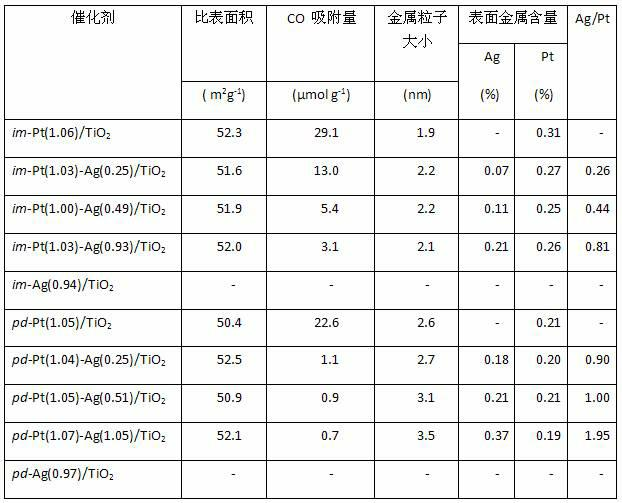Selective hydrogenation dechlorination catalyst for 1,2-dichloroethane, as well as preparation method and application thereof
A dichloroethane, hydrodechlorination technology, applied in catalyst activation/preparation, metal/metal oxide/metal hydroxide catalysts, chemical instruments and methods, etc., can solve the problem that the dechlorination capacity cannot be effectively utilized, etc. problem, to achieve the effect of significant treatment effect, good economic benefits and maintaining stability
- Summary
- Abstract
- Description
- Claims
- Application Information
AI Technical Summary
Problems solved by technology
Method used
Image
Examples
Embodiment 1
[0029] Preparation of Pt-Ag / TiO by Continuous Photodeposition 2 Catalyst, the specific method is: add 10ml of methanol to 480ml of the solution containing a certain amount of titanium dioxide and a certain amount of Pt salt, add it to the photoreactor, and pass N 2 Gas for 30 minutes, then turn on the UV lamp (500w), react under light conditions for 4 hours, filter and wash with distilled water until the pH is neutral, and dry. Then, the metal Ag was loaded on the catalyst support in the same manner as the above-mentioned loading metal Pt. The obtained catalyst was stored in a desiccator for further use.
[0030] As a comparison, Pt or Ag single-metal catalysts were prepared by photodeposition method and TiO2-supported catalysts were prepared by impregnation method.
[0031] The characterization results of the catalysts prepared by the two methods are shown in Table 1 below, and the catalysts prepared by the impregnation method in Table 1 are marked as: im -A(x)-B(y) / TiO 2...
Embodiment 2
[0036] Preparation of Pt-Ag / TiO by Continuous Photodeposition 2 Catalyst, wherein the Pt load is about 1%, and the molar ratio of Pt and Ag is about 1:0.5, i.e. in Example 1 pd -Pt(1.04)-Ag(0.25) / TiO 2 catalyst. With the above Pt-Ag / TiO 2 As a catalyst, gas-phase hydrogenation catalytically degrades 1,2-dichloroethane. The consumption of catalyst is 100mg, the reaction temperature is 200~250℃, H 2 The concentration of 1,2-dichloroethane is 30000~40000ppm, the concentration of 1,2-dichloroethane is 7000~7500ppm, He is used as the carrier gas, the flow rate of the mixed gas is 40~50ml / min, and the reaction time is 18~21h under normal pressure. Detector gas chromatography on-line detection. The results show that the selectivity to the target product ethylene is 74.3~89.0%.
Embodiment 3
[0047] Pt-Ag / TiO with a Pt loading of about 1% and an atomic molar ratio of Pt and Ag of about 1:1 prepared by photodeposition 2 As a catalyst, it is the pd -Pt(1.05)-Ag(0.51) / TiO 2 Catalyst, gas phase hydrogenation catalytic degradation of 1,2-dichloroethane. The consumption of catalyst is 100mg, the reaction temperature is 200~250℃, H 2 The concentration of 1,2-dichloroethane is 30000~40000ppm, the concentration of 1,2-dichloroethane is 7000~7500ppm, with He as the carrier gas, the flow rate of the mixed gas is 40~50ml / min, and the reaction time is 17~19h at normal pressure. The selectivity of the catalyst 86.7~87.6%.
[0048] It can be seen that increasing the molar ratio of Pt and Ag can accelerate the time for the catalyst to reach stability and improve the selectivity of the catalyst.
PUM
 Login to View More
Login to View More Abstract
Description
Claims
Application Information
 Login to View More
Login to View More - R&D
- Intellectual Property
- Life Sciences
- Materials
- Tech Scout
- Unparalleled Data Quality
- Higher Quality Content
- 60% Fewer Hallucinations
Browse by: Latest US Patents, China's latest patents, Technical Efficacy Thesaurus, Application Domain, Technology Topic, Popular Technical Reports.
© 2025 PatSnap. All rights reserved.Legal|Privacy policy|Modern Slavery Act Transparency Statement|Sitemap|About US| Contact US: help@patsnap.com

